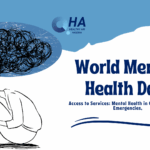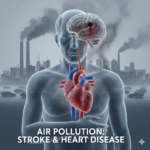You wake up early, start your day with a green smoothie, and meal-prep your quinoa and vegetables for lunch. You drink enough water, track your calories, and avoid processed sugar. Very healthy living, you may presume. Why then do we still experience health problems like allergies, respiratory illnesses, Heart attacks, Strokes etc.
Breathing toxic air inside your own home, office, classroom or hospital is an invisible threat silently undoing all your effort.
The reality is, you can eat clean and still live unhealthy if the air you breathe is dirty.

The Forgotten Half of Wellness
We live in a world obsessed with what goes into our mouths but blind to what we inhale. From diet fads to detox teas, everyone talks about “healthy diet” yet few ever mention healthy breathing.
But think about it: You can survive weeks without food, days without water, but only few seconds/minutes without air.
Indoor air is up to five times more polluted than outdoor air, according to the World Health Organization. And we spend roughly 90% of our lives indoors; at home, in offices, schools, gyms, restaurants and even hospitals. This implies that the air you’re breathing indoors is filled with pollutants including mould spores, bacteria, viruses, and volatile chemicals from cleaning agents, cosmetics and fragrances. This makes the idea of a “healthy” lifestyle by just eating healthy a sudden and silent contradiction. Because, while your diet might be nourishing your body, your lungs and by extension, your heart, brain, and immune system could be starving for clean air.

What’s Lurking in Your “Healthy” Home
That faint smell of cleaning spray. The new furniture you just bought. The humidity in your bathroom. The closed windows when it rains, that colleague who keeps sneezing, coughing and sniffing. Each one is releasing harmful particles, gases, and microbes that quietly build up in your indoor environment for you to inhale.
Here’s what might be floating around unseen:
- Volatile Organic Compounds (VOCs): From paints, air fresheners, and cleaning products. They irritate lungs and can cause headaches or nausea.
- Mould and Mildew Spores: Thrives in damp corners, air-conditioned spaces, and bathrooms making such environment major triggers for allergies and asthma.
- Dust Mites and Pet Dander: Invisible to the eye but powerful irritants to your airways.
- Carbon Dioxide Buildup: Especially in airtight modern homes or offices, it lowers alertness and productivity.
The result? Fatigue that no smoothie can fix. Headaches your vitamins can’t cure. And a weakened immune system even your supplements can’t strengthen.
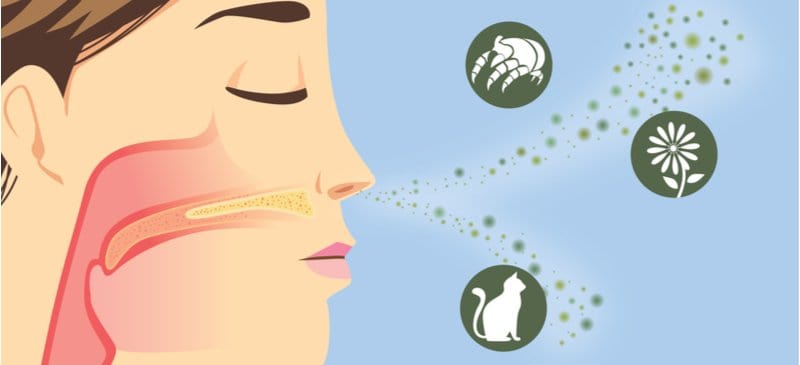
Your Brain Breathes Too
Clean air isn’t just about your lungs; It’s about your mind.
Studies have shown that people who work or study in polluted indoor environments experience slower cognitive performance, reduced concentration, and higher stress levels.
One Harvard study even found that poor indoor air quality can cut cognitive performance by up to 61%. That means your brain literally works less efficiently when your air is dirty.
So yes, while kale fuels your cells, air fuels your thoughts.
Air Quality and the Body’s Silent Battle
Here’s a reality check: your body doesn’t treat polluted air lightly. Every breath of contaminated air sets off a micro-inflammation chain reaction, that is, your immune system is made to work overtime to protect you. This eventually leads to;
- Chronic fatigue and poor sleep
- Heightened allergies or respiratory illness
- Increased risk of heart disease and stroke
- Accelerated ageing (due to oxidative stress)
- Enhanced risk of autoimmune diseases
It’s a battle you can’t see, but your body fights it every single day.
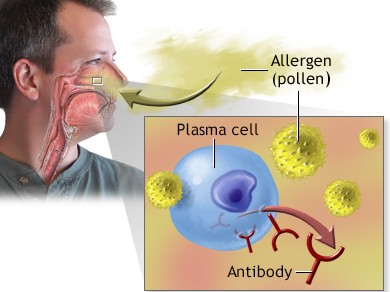
The Missing Piece: Purifying the Air You Live-In
If you’ve mastered healthy eating, the next logical step is healthy breathing.
And that starts with indoor air purification, not with fragrances (air fresheners, perfumes or sprays), but with science.
New innovations like the Healthy Air DNO Catalyst Purifier, do more than filter dust. They break down pollutants at the molecular level turning bacteria, viruses, mould spores, and harmful gases into harmless, pure oxygen-rich air.
No toxins left behind. Just pure, breathable air that complements your healthy diet. Think of it as an armour for your lungs and peace of mind for your home or business.
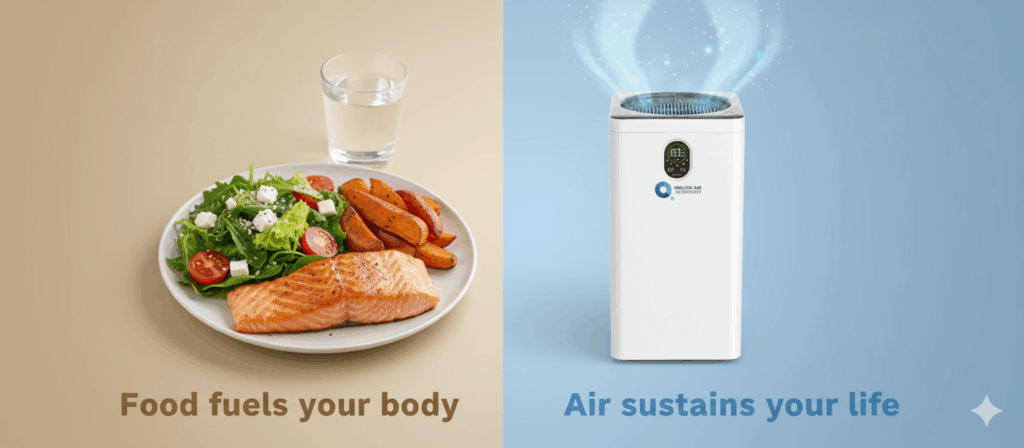
You Are What You Eat and What You Breathe Too
Food fuels your body. Air sustains your life. Both determines your health.
So, while you count your calories, remember to count your breaths and make sure each one is clean, pure, and life-giving. Because real wellness isn’t just in your diet plan. It’s in the air you live, work, study, sleep, and dream in.
Final Takeaway
You can eat organic, drink alkaline water, and still feel drained if your air is polluted.
Clean air is not a luxury; It’s a daily nutrient your body needs as much as food.
So yes, keep eating healthy. But breathe healthier, too.
Because the true recipe for wellness is simple:
Healthy Diet. Healthy Air. Full Life.

